Ankle Joint Pain case file
A patient, Miss P, a highly competitive runner for the last 15 years, enjoyed a normal 10k run several weeks back, all without incident. But the following day she woke up enormous pain in her right lower limb.
She recalls having injured her foot quite badly several
years previously, but it resolved without comment and without any treatment. Perhaps it left her with a subtalar fixation, but that
is speculative; that what she had on presentation at the clinic. Look for it in the diagram below.
Walking on the inside part of foot, known as eversion, together with an exaggerated heel to toe posture on the inner side of her foot she said brought her relief. This would have prevented the normal pronation supination that you can read about below. It stopped her from rolling the subluxated subtalar joint in the usual normal manner.
Normal walking posture provoked the sharp stabs. That would involve pronation and supination. She said the ankle was very stiff in the morning and it woke her up during the night, but with no sign of swelling.
She described the pain as deep and boring. It felt like bone pain. She thought originally that it was a dancer's fracture; it was that intense. From overuse of the muscles on the side of the leg, the Peronei muscles, she thought must have been causing the ache in her lower limb.
This page was last updated by Dr Barrie Lewis on 26th January, 2019.
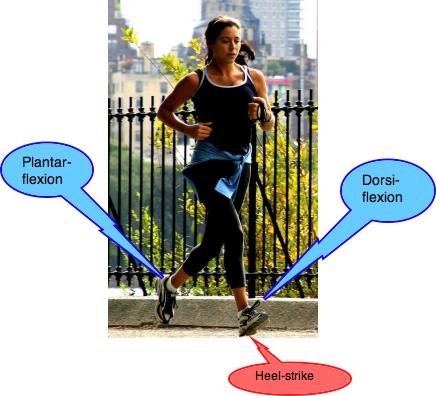
Ankle Joint Pain case file
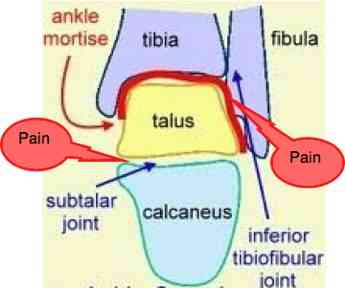
That Peroneus is in fact three separate muscles, and the tendons do indeed pass very close to the subtalar joint.
Examination of our ANKLE JOINT PAIN CASE FILE
The movement we call EVERSION of the ankle was severely reduced with moderate tenderness over the anterior part of the subtalar joint. Otherwise there were few findings. See the subtalar joint in the pic above? And where the arrows are in the X-ray below. That's where I found the spoke in her wheel.
PROGRESS in our ANKLE JOINT PAIN CASE FILE
She reported immediate relief of ankle joint pain after the first Chiropractic adjustment of the subtalar joint and within four treatments, in two weeks, she was completely over the pain and running normally again.
Impossible, a miraculous recovery with Chiropractic Help? Because she knew she had an injury, and didn't wait weeks, or months, or ... yes, we see people with this injury often years after it has happened. She presented herself two days after the injury.
Now, says she, when I do peroneal strengthening and stretching it feels lekker. Good, or nice. Ankle exercises are a vital part of ankle sprain treatment.
The SUBTALAR or TALO-CALCANEAL JOINT (actually jointS)
ANKLE JOINT PAIN CASE FILE
This is a synovial joint meaning that it is filled with a lubricating fluid full of juicy chemicals and oxygen that feed the stuff which lines the bones in most joints - what we call hyaline cartilage . It's at the heart of ankle sprain treatment. This cartilage is very hard, gives slightly on pressure, and is extra very super-slippery.
An aside: Try making our CHIROPRACTIC HELP mutton stew from neck of lamb. Delic, and easy. Whilst you're enjoying a finger-licking-good neck bone, run your finger over one of the joints. Super-slippery. That's what healthy hyaline cartilage looks and feels like. Allow that joint to subluxate, and remain fixated, and (within 13 hours the anatomists tell us) that hyaline cartilage, starved of nutrients begins to lose it's super-smoothness. It's called IMMOBILISATION ARTHRITIS.
(PS. Pay Colonel Saunders a visit this week. He had a rotten back, and was eventually saved by a Chiropractor. He was so impressed that he gave a $100 000 every semester to our Chiropractic College for needy students. I really owe him ...! Then save the chicken bones and make your own cartilage nutrient bouillon, a proven big help for stubborn arthritis. )
- HYALINE CARTILAGE ...
- IMMOBILISATION ARTHRITIS ...
- MUTTON STEW ...
The CALCANEUS, or HEEL BONE
ANKLE JOINT PAIN CASE FILE
The CALCANEUS, is the largest bone in the foot, and it takes a pounding! When you walk and run it's your heel that you land on, and it takes the full weight of the body.
As you can see it's a highly complex bone ...
Fig. 4
Google appears to frown on too many links, so phrases in bold, like that immobilisation arthritis above, or Stones in my Clog below, need to be put into the Site Search function in the navigation bar on your left if you want more information.
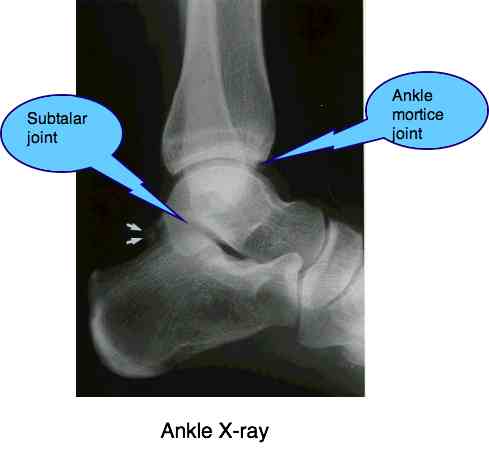
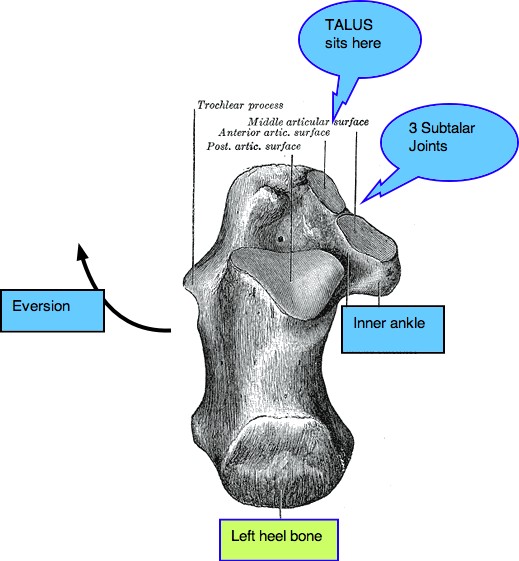
ANKLE JOINT PAIN CASE FILE: Why do I do it?
Friends and colleagues, and "she who must be obeyed"!, sometimes ask why I "waste" so much time writing Chiropractic Help. A good question, and yes it does take a lot of time. Each of these pages takes at least 2-3 hours, this one much longer.
- I just enjoy it. Strange, but I find it fun and relaxing.
- I find patients have very little idea of what and why we Chiropractors do, and why the art and science of Chiropractic is so important. Chiropractic Help is a good teaching tool - I do it for you!
- Periodically I get fed up with my alter ego, Dr Bernard Preston. Yes, I lead a double life! Writing Bernard Preston's fanciful tales from the Chiropractic Coalface is very monotonous. Seriously, each chapter from my new book has been written, read, re-read, edited ... at least thirty times. It's SIX WHOLE YEARS since I started STONES IN MY CLOG, no exaggeration. It's tedious, so I escape Bernard Preston's clutches periodically, to rather enjoy your company at CHIROPRACTIC HELP! You're much nicer than that 'ole fart Preston! BERNARD PRESTON ...
Stones in my Clog - only $2.99 on your Kindle or smartphone.

Shall we be serious again? Chiropractic Help is also an important learning tool for me. Believe it or not, I've been treating the subtalar joints for years, and I had no idea there were three of them until now. Do you think that helps my understanding of ankle joint pain, and allows me to better help patients with ankle sprain treatment? Absolutely.
If the master found it important, then it's important for me too. And you, are you still learning?
"I'm still learning."
- Michaelangelo
(said when he was 85)
- CHIROPRACTIC CONTINUING EDUCATION ...
Back to our ANKLE JOINT PAIN CASE FILE
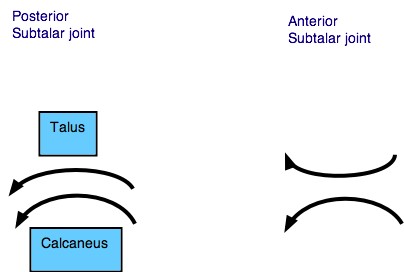
ANKLE JOINT PAIN CASE FILE
What's interesting about the Posterior Talo-Calcaneal joint (remember: Subtalar = Talo-Calcaneal, just another name for the same joint) is that the Talus above, and the Calcaneus below have matching concave surfaces. Go back to Fig 2 and look at those little arrows. That makes the joint very stable and solid, and able to take the shock of the heel landing with the foot in dorsiflexion.
However, the Anterior Subtalar joint is convex-concave allowing the foot to roll onto the Medial Subtalar joint, what we call pronate-supinate when the foot is neutral and in plantar flexion.
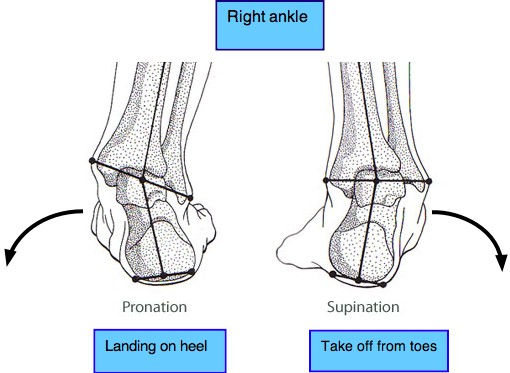
PRONATION SUPINATION
ANKLE JOINT PAIN CASE FILE
Ankle bone anatomy is a fascinating subject. We are truly, as one surgeon wrote, fearfully and wonderfully made. He's absolutely right!
When you are walking or running, you land on your heel with the foot in dorsiflexion. The stable posterior subtalar joint takes the shock beautifully.
Then, the foot goes into slight plantar flexion (drops), allowing the weight to be taken over the the anterior and medial subtalar joints which are convexo-concave, and your foot can roll inwards, in what we call pronation. It's quite normal, and happens on every stride.
Then, mid-stride, the knee moves forwards over the toes, and the foot is again moving into more rigid and stable dorsiflexion for the toe-off phase of your stride. Now, as the foot plantar flexes during toe-off, the ankle rolls outwards, into what we call supination. This supination apparently, from an engineering perspective, gives the calf muscles more leverage as you push off. Beautiful, beautiful ankle anatomy.
Every step, roll in, roll out, pronation, supination.
To complete our ANKLE JOINT PAIN Case File here are a few more thoughts.
During our young friend's jog, something went haywire in the anterior-medial subtalar joints. This joint stuff is all a bit mysterious, I must admit. We find it just as frequently with low back pain - you go to bed fine, you didn't have sex!, a normal night's sleep, and in the morning you roll out of bed and bingo. Ouch, +++ lower back pain.
My take is that a joint fixates from some, perhaps seemingly minor, injury during the day. You're not aware of it. You go to bed fine, but during the night, the normal refreshment of the joint fluids is inhibited by the fixation, it swells perhaps deep inside the joint, and you wake up in the morning with severe pain.
It's one of the reasons I stress exercising your quirky joints IN BED, last thing at night and before getting up in the morning. Two minutes, that's all it takes, will save you heaps of drama.
When you know you've done a mischief to your back (watched "The Two Ronnies"? - the very best of Brit humour) or your ankle, don't wait weeks before you consult your Chiropractor. And don't waste your time with anti inflammatory drugs and painkillers - get that subluxation reduced as quickly as you can. Ice, taping for your ankle sprain treatment and an ankle guard for a while may help too.
USEFUL LINKS
- ANTI INFLAMMATORY DRUGS ...
- FOOT PAIN home page ...
- Another far more serious ANKLE JOINT PAIN CaseFile ...
- ANKLE SPRAIN TREATMENT ...
Have A Question About Your Foot?
Share your question. Perhaps I or someone else can contribute to the misery that foot and ankle joint pain can cause.
What Other Visitors Have Said
Click below to see contributions from other visitors to this page...
Ankle Hurts to Walk On; no Swelling or Bruising 




Ankle Hurts to Walk On; no Swelling or Bruising
One week ago, I was walking on an even surface in platforms and fell, my ankle rolled outwards and my …
Ankle trouble Not rated yet
Home > Ankle exercises > Injuries of the Ankle
I have had escalating pain in my ankle for over a month now; I slightly …
Ailments of the foot and chiropractic treatment for them Not rated yet
Went to chiropractor for neck adjustment. He tried new foot technique on my foot without asking, and now great toe and side of foot tingly. Also top to …
Did you find this page useful? Then perhaps forward it to a suffering friend. Better still, Tweet or Face Book it.
